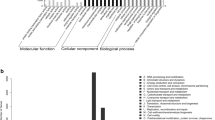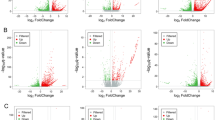Abstract
Cadmium (Cd) pollution is a serious heavy metal pollution in paddy fields, but its effect and underlying mechanism on soil arthropod overwintering and cold resistance are still unclear. In the present study, adult females of the wolf spider Pirata subpiraticus exposed to Cd stress underwent a simulated temperature process (25℃ → 16℃ → 8℃ → 4℃). The mortality rate and content of nutrients in the Cd-treated spiders were dramatically elevated after low-temperature treatment compared to those in the Cd-free control spiders under the same temperature condition. To uncover the putative modulatory mechanism of Cd on cold tolerance in P. subpiraticus, we employed an in-depth RNA sequencing analysis and yielded a total of 888 differentially expressed genes (DEGs). Besides, we characterized genes that participate in multiple cryoprotectant syntheses, including arginine, cysteine, glucose, glycerol, heat shock protein, and mannose. The enrichment analyses found that most of the DEGs involved in biological processes and pathways were related to carbohydrate, lipid, and protein metabolism. Notably, ten Kyoto Encyclopedia of Genes and Genomes (KEGG) pathways, such as starch and sucrose metabolism, arachidonic acid metabolism, amino acid metabolism, mineral absorption, and vitamin digestion and absorption, were distinctively enriched with downregulated genes. Meanwhile, we also identified that seven DEGs might inhibit the KEGG pathway of ovarian steroidogenesis and potentially cripple ovarian function and fecundity in the spider. The decreased egg sac weight, number of hatched spiderlings, and vitellin concentration further supported the view that Cd exposure vitiates the overwintering spider’s fecundity. Collectively, the comparative analysis provides a novel perspective regarding the survival response and fecundity on the cold tolerance of spiders under Cd stress and offers a profound insight for evaluating Cd-induced toxicity on overwintering arthropods.






Similar content being viewed by others
Data availability
The data used to support the findings of this study are available from the corresponding author upon request.
References
Bonnot G et al (1998) The effect of cold acclimation and deacclimation on cold tolerance, trehalose and free amino acid levels in Sitophilus granarius and Cryptolestes ferrugineus (Coleoptera). J Insect Physiol 44(10):955–965
Chen M et al (2009) Analysis of Cry1Ab toxin bioaccumulation in a food chain of Bt rice, an herbivore and a predator. Ecotoxicol 18(2):230–238
Davidson NM et al (2014) Corset: enabling differential gene expression analysis for de novo assembled transcriptomes. Genome Biol 15(7):410
de Jong MA, Saastamoinen M (2018) Environmental and genetic control of cold tolerance in the Glanville fritillary butterfly. J Evolution Biol 31(5):636–645
De Loof A, Schoofs L, Huybrechts R (2016) The endocrine system controlling sexual reproduction in animals: part of the evolutionary ancient but well conserved immune system? Gen Comp Endocr 226:56–71
Deng MH et al (2020) Metals source apportionment in farmland soil and the prediction of metal transfer in the soil-rice-human chain. J Environ Manage 260:110092
Dewey CN et al (2011) RSEM: accurate transcript quantification from RNA-Seq data with or without a reference genome. BMC Bioinf 12(1):323–323
Du Laing G et al (2002) Heavy metal contents (Cd, Cu, Zn) in spiders (Pirata piraticus) living in intertidal sediments of the river Scheldt estuary (Belgium) as affected by substrate characteristics. Sci Total Environ 289(1–3):71–81
Du Y et al (2013) Affects of mining activities on Cd pollution to the paddy soils and rice grain in Hunan province, Central South China. Environ Monit Assess 185(12):9843–9856
Duman JG (2015) Animal ice-binding (antifreeze) proteins and glycolipids: an overview with emphasis on physiological function. J Exp Biol 218(12):1846–1855
Eraly D et al (2011) Direct and indirect effects of metal stress on physiology and life history variation in field populations of a lycosid spider. Ecotox Environ Safe 74(6):1489–1497
Foelix RF (2011) Biology of spiders. Oxford University Press, Oxford
Genchi G et al (2020) The effects of cadmium toxicity. Int J Env Res Pub He 17(11):3782
Grabherr MG et al (2013) Trinity: reconstructing a full-length transcriptome without a genome from RNA-Seq data. Nat Biotech 29:644
Guo S et al (2021) Steroid hormone ecdysone deficiency stimulates preparation for photoperiodic reproductive diapause. Plos Genet 17(2):e1009352
Hendrickx F, Maelfait JP, Langenbick F (2003) Absence of cadmium excretion and high assimilation result in cadmium biomagnifications in a wolf spider. Ecotoxicol Environ Saf 55(3):287–292
Hendrickx F, Maelfait JP, Lens L (2008) Effect of metal stress on life history divergence and quantitative genetic architecture in a wolf spider. J Evolution Biol 21(1):183–193
Huang YY et al (2017) Toxicity of cadmium and its health risks from leafy vegetable consumption. Food Funct 8(4):1373–1401
Jung MP, Lee JH (2012) Bioaccumulation of heavy metals in the wolf spider, Pardosa astrigera L. Koch (Araneae: Lycosidae). Environ Monit Assess 184(3):1773–1779
Kojic D et al (2018) The influence of low temperature and diapause phase on sugar and polyol content in the European corn borer Ostrinia nubilalis (Hbn.). J Insect Physiol 109:107–113
Li JQ et al (2002) Biology and ecology of the wolf spider Pirata subpiraticus. Acta Ecol Sin 22(9):1478–1484
Liu SJ et al (2021) Status and environmental management of soil mercury pollution in China: a review. J Environ Manage 277:111442
Lv B et al (2020) Transcriptome sequencing reveals the effects of cadmium toxicity on the cold tolerance of the wolf spider Pirata subpiraticus. Chemosphere 254:126802
Lv B et al (2021) Cadmium exposure alters expression of protective enzymes and protein processing genes in venom glands of the wolf spider Pardosa pseudoannulata. Environ Pollut 268:115847
Neelakanta G et al (2012) Expression of ixodes scapularis antifreeze glycoprotein enhances cold tolerance in Drosophila melanogaster. Plos One 7(3):e33447
Palandri A et al (2015) Frataxin inactivation leads to steroid deficiency in flies and human ovarian cells. Hum Mol Genet 24(9):2615–2626
Renault D et al (2016) Chronic exposure to soil salinity in terrestrial species: does plasticity and underlying physiology differ among specialized ground-dwelling spiders? J Insect Physiol 90:49–58
Satarug S et al (2010) Cadmium, environmental exposure, and health outcomes. Environ Health Persp 118(2):182–190
Tardy AL et al (2020) Vitamins and minerals for energy, fatigue and cognition: a narrative review of the biochemical and clinical evidence. Nutrients 12(1):228
Toxopeus J, Sinclair BJ (2018) Mechanisms underlying insect freeze tolerance. Biol Rev 93(4):1891–1914
van Dronkelaar C et al (2018) Minerals and Sarcopenia; the role of calcium, iron, magnesium, phosphorus, potassium, selenium, sodium, and zinc on muscle mass, muscle strength, and physical performance in older adults: a systematic review. J Am Med Dir Assoc 19(1):6–11
Wang J et al (2019) Expression and functional analysis of cytochrome P450 genes in the wolf spider Pardosa pseudoannulata under cadmium stress. Ecotox Environ Safe 172:19–25
Wang J et al (2020) Mul-tiomics analysis of cadmium stress on the ovarian function of the wolf spider Pardosa pseudoannulata. Chemosphere 248:125904
Wang XF et al (2011) Biochemical experimental technology. Chi Forest Pub. (in Chinese)
Wilczek G et al (2004) Relations between metals (Zn, Pb, Cd and Cu) and glutathione-dependent detoxifying enzymes in spiders from a heavy metal pollution gradient. Environ Pollut (Barking, Essex : 1987) 132(3):453–461
Wilczek G et al (2019) Effect of long-term cadmium and copper intoxication on the efficiency of ampullate silk glands in false black widow Steatoda grossa (Theridiidae) spiders. Comp Biochem Phys C 224:108564
Wu GY (2009) Amino acids: metabolism, functions, and nutrition. Amino Acids 37(1):1–17
Wu HW et al (2020) Heavy metal (loids) in typical Chinese tobacco-growing soils: concentrations, influence factors and potential health risks. Chemosphere 245:125591
Yang HL et al (2016a) Spiders as excellent experimental models for investigation of heavy metal impacts on the environment: a review. Environ Earth Sci 75(13):1–6
Yang YJ et al (2016b) Impacts of nitrogen fertilizer on major insect pests and their predators in transgenic Bt rice lines T2A–1 and T1C–19. Entomol Exp Appl 160(3):281–291
Yang ZJ et al (2018) Spatial distribution and sources of seven available heavy metals in the paddy soil of red region in Hunan Province of China. Environ Monit Assess 190(10):611
Yang HL et al (2021) Cadmium-induced oxidative stress and transcriptome changes in the wolf spider Pirata subpiraticus. Sci Total Environ 785:147364
Yoon YE et al (2017) Influence of cold stress on contents of soluble sugars, vitamin C and free amino acids including gamma-aminobutyric acid (GABA) in spinach (Spinacia oleracea). Food Chem 215:185–192
Yu X et al (2002) A study on the dispersal of lycosid spider, Pirata subpiraticus between rice and Zizania fields. Acta Entomol Sin 45(5):636–640
Zhang X et al (2015) Assessment of cadmium (Cd) concentration in arable soil in China. Environ Sci Pollut Res Int 22(7):4932–4941
Zhou XW et al (2019) Relationships between Pb, As, Cr, and Cd in individual cows’ milk and milk composition and heavy metal contents in water, silage, and soil. Environ Pollut 255:113322
Zhou X et al (2020) Functional analysis of ecdysteroid biosynthetic enzymes of the rice planthopper, Nilaparvata lugens. Insect Biochem Molec 123:103428
Zmudzki S, Laskowski R (2012) Biodiversity and structure of spider communities along a metal pollution gradient. Ecotoxicol 21(5):1523–1532
Zwolak I (2020) The role of selenium in arsenic and cadmium toxicity: an updated review of scientific literature. Biol Trace Elem Res 193(1):44–63
Acknowledgements
Our deepest gratitude goes to the anonymous reviewer(s) for their careful work and thoughtful suggestions that helped improve this paper substantially. We would like to thank Professor Qi-sheng Song (Division of Plant Science and Technology, University of Missouri) for his technical supports and helpful editing.
Funding
This work was supported by the National Natural Science Foundation of China (Nos. 31472017, 31272339), Project of Science and Technology Department of Hunan Province (No.2014FJ2003), Tropical Disease Control and Research, Ministry of Education in China (2018kfkt03), Natural Science Foundation of Hunan Province (2020JJ4427), and Key Project of Education Department of Hunan Province (18A024).
Author information
Authors and Affiliations
Contributions
ZW: conceptualization and methodology. BL: data curation, writing—original draft, and visualization. JzZ: formal analysis and supervision. YdP: material preparation.
Corresponding author
Ethics declarations
Ethics approval
The ethical approval was not required. The materials used in this study were unregulated common arthropod spiders, P. subpiraticus, and insect D. melanogaster.
Consent to participate
Not applicable.
Consent to publish
Not applicable.
Competing interests
The authors declare no competing interests.
Additional information
Responsible Editor: Giovanni Benelli
Publisher's note
Springer Nature remains neutral with regard to jurisdictional claims in published maps and institutional affiliations.
Supplementary Information
Below is the link to the electronic supplementary material.
Rights and permissions
About this article
Cite this article
Lv, B., Zhuo, Jz., Peng, Yd. et al. Comparative analysis of cadmium-induced toxicity and survival responses in the wolf spider Pirata subpiraticus under low-temperature treatment. Environ Sci Pollut Res 29, 32832–32844 (2022). https://doi.org/10.1007/s11356-022-18548-w
Received:
Accepted:
Published:
Issue Date:
DOI: https://doi.org/10.1007/s11356-022-18548-w




